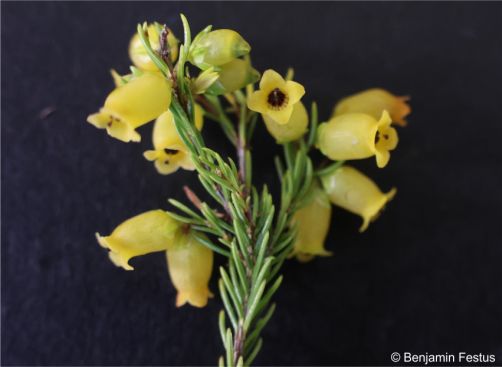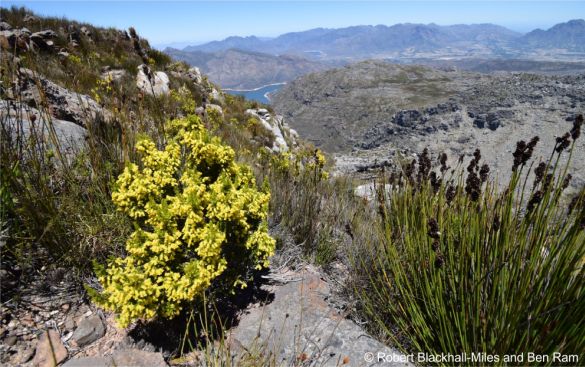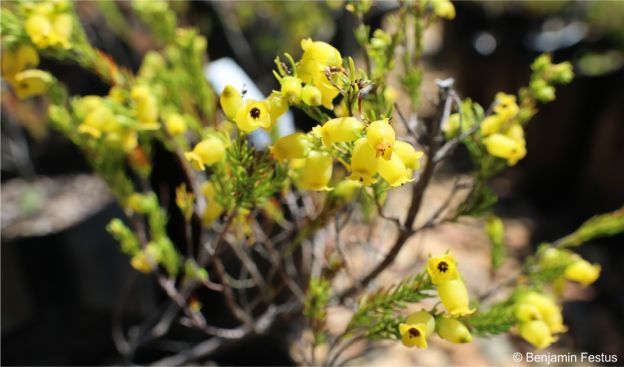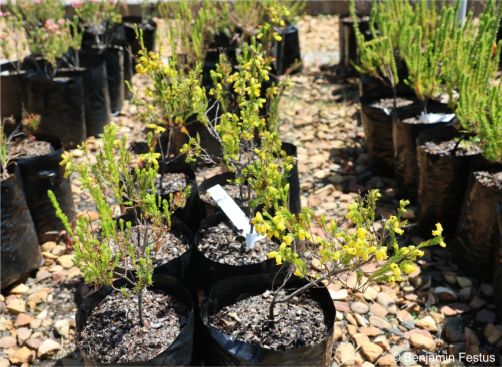Erica blandfordia
Erica blandfordia Andrews
Family: Ericaceae
Common names: yellow wax heath (Eng.); geelwasheide (Afr.)
Introduction
Erica blandfordia gives a show of bright yellow flowers in spring and early summer.

Description
Description
This plant is an upright shrublet, not particularly tall in appearance, it reaches a height of 700-900 mm when mature. The small, yellow, urn-shaped flowers are 6-8 mm long, arranged in fours (4-nate) and presented in dense heads on the branches, which makes the whole plant look very noticeable among other plants. The anthers are aristate (with horn-like appendages). The leaves 4-nate and about 4 mm long. Flowering time is in spring and early summer, from September to December.

Conservation Status
Status
According to the SANBI Red List of South African Plants, Erica blandfordia is currently assessed as Least Concern (LC).
Distribution and habitat
Distribution description
Erica blandfordia is endemic to southern Africa and has a Western Cape distribution. The species is quite widespread, it is recorded in the Drakenstein Mountains, the Du Toitskloof and Stettynskloof Mountains and also in the Wolseley area, where it has established itself on the dryer mountain slopes, especially the middle to upper slopes of the mountains.

Derivation of name and historical aspects
History
The genus name Erica derives from the Latin word ereiko which means heath or broom. The specific epithet blandfordia refers to the Marquis of Blandford who was a patron of botany in the eighteenth century, the plant was named in honour of this patron.
The genus Erica comprises about 800 species, of which approximately 700 species are indigenous to South Africa. Ericas flourish in the Fynbos Biome of the Western Cape Province, where 600 species are found, but not in the dry Karoo. Ericas also occur in other parts of the world such as Europe where they are known as heathers. Ericas are also common in Madagascar and the Mediterranean region.

Ecology
Ecology
Erica blandfordia was observed to be visited by insects. These visitors to the plant contribute to the pollination process and at the same time benefit from nectar as a food source for them. Some ericas are very slow-growing and seem to live longer. In contrast, others are adapted to grow among rocks, a survival strategy against threats such as being eaten by herbivores. The shape of the flowers may also determine which pollinators come and visit their flowers. Erica seeds are very tiny and mainly dispersed by wind.
Uses
Use
Erica blandfordia can be used as part of a cut-flower arrangement as their waxy flowers are quite long-lasting. This plant with its bright yellow flowers can give an interesting contrast when planted among other fynbos plants. Erica blandfordia makes an excellent pot plant, you need to ensure that the potting medium is in the acidic range and provides good drainage.

Growing Erica blandfordia
Grow
Erica blandfordia can be successfully grown in garden plant beds provided that it is positioned in an area that receives full sun and good soil drainage is maintained. The soil pH should be in the acidic range (4 to 5.5). The plants should not be planted too densely, good air circulation is important. This plant has no taproot, but has a a delicate, hair-like root system and care must be taken not to damage the roots when cultivating these plants. Prune the plant after flowering to encourage new growth and to clean up the plant by removing dead or damaged wood. Organic fertilisers may be added in low concentrations. Adding a layer of mulch, consisting of wood chips, is ideal to assist in controlling weeds and to keep the soil moist.
Erica blandfordia can be successfully propagated by taking semi-hardwood cuttings ±40-50 mm long, ideally two months after flowering, as a general rule for propagating ericas. Use heel cuttings or nodal cutting; at Kirstenbosch we find that heel cuttings deliver better results. Select healthy and disease-free plants. Different soil media are available, however we recommend a rooting medium of fine-milled bark mixed with perlite balls at a 50:50 ratio, which has proved to result in good rooting. The rooting media should be well-drained and heated propagation benches should be kept at a constant temperature of 24°C.
Transplant the rooted cuttings into small pots using a soil mix that is a ratio of 7 parts milled bark and 3 parts sand, which is an ideal medium for further development of the young cuttings. Cuttings will develop into young plants much quicker than seed-grown plants. Harden the cuttings off for a month before placing in open environmental conditions. The cuttings will be ready for planting after about 3 months.
Seeds need to be treated with smoke first, such as soaking them in a fynbos smoke extract, and sown in autumn. Seed germination varies from one to two months. Feed the rooted cuttings with liquid organic fertiliser every 14 days. As a general guideline for sowing erica seed, use equal parts of river sand and sifted composted bark in 100 mm deep seed trays. Do not sow seeds too densely, mixing the seeds with fine river sand and spreading this over the surface of the tray will ensure a more even spread of the seeds. Apply water lightly and shelter the seeds from direct sunlight.
Young plants are often plagued by mealybug, control them by applying an organic contact pesticide or a systemic control that can be added to the soil medium. Prevent root disease by ensuring that the potting medium has sufficient drainage, the soil of garden plant beds also requires good drainage.
References
- Blackhall-Miles, R. & Ram, B. 2017-12. Observation of Erica blandfordia, Haelhoek Sneeukop, Western Cape. iNaturalist. Online. https://www.inaturalist.org/observations/9451594.
- Goldblatt, P. & Manning, J. 2000. Cape Plants. A conspectus of the Cape flora of South Africa. Strelitzia 9. National Botanical Institute, Pretoria & Missouri Botanical Garden, Missouri.
- iNaturalist. Wax Heath (Erica blandfordia). https://www.inaturalist.org/taxa/1035321-Erica-blandfordia. Accessed 16 October 2024.
- Raimondo, D., Von Staden, L., Foden, W., Victor, J.E., Helme, N.A., Turner, R.C., Kamundi, D.A. & Manyama, P.A. (eds) 2009. Red list of South African plants. Strelitzia 25. South African National Biodiversity Institute, Pretoria.
- Schumann, D., Kirsten, G. & Oliver, E.G.H. 1992. Ericas of South Africa. Fernwood Press, Vlaeberg.
- Van der Merwe, A. 2006. Illustration of Erica blandfordia Andrews for Flowering Plants of Africa 39, plate no. 1534. Accessed via JSTOR Global Plants. https://plants.jstor.org/stable/pdf/10.5555/al.ap.visual.preart0002794.
- World Flora Online. 2024. Erica blandfordia Andrews. https://www.worldfloraonline.org/taxon/wfo-0000671517. Accessed on: 16 Oct 2024.
Credits
Benjamin Festus
Kirstenbosch National Botanical Garden
November 2024
Acknowledgements: Photo of Erica blandfordia in habitat by Robert Blackhall-Miles and Ben Ram.
Plant Attributes:
Plant Type: Shrub
SA Distribution: Western Cape
Soil type: Sandy
Flowering season: Spring, Early Summer
PH: Acid
Flower colour: Yellow
Aspect: Full Sun
Gardening skill: Average
Special Features:
Horticultural zones








Rate this article
Article well written and informative
Rate this plant
Is this an interesting plant?
Login to add your Comment
Back to topNot registered yet? Click here to register.